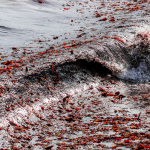A few of my recent posts on Instagram feature slow shutter speed shots of waves breaking, it’s a style that grabs attention more than your standard empty wave shot and can definitely appeal to a broader range of people than a crisp wave.
Here’s my top five tips on getting good results next time you fancy trying out long exposure wave photography:
- Fill the frame – try and get tight in on the wave, you usually want as much movement in the shot as possible, and ideally in a circular motion as the lip is pitching.
- Look for textures in the water – Many of the shots I posted were of waves breaking with a lot of seaweed in the water, the extra texture you get from the seaweed enhances the blurred long exposure, creating more of a brush stroke like pattern.
- Add some colour – if your water is dull try adding some colour in Lightroom or photoshop, use the hue controls to bring out the colours that appear in the shot and give it some interest.
- Shoot in the early morning or late evening – you can use longer shutter speeds without needing a neutral density filter and it’s a great way to get some shots before or after it’s light enough to take more traditional action photo’s.
- Use a shutter speed of between 1/4 and 1/20th of a second – with slower speeds giving you more abstract results, shooting in shutter priority mode will help get your exposure right but make sure you’re not overexposing the image, your aperture will blink in the viewfinder if you’re going to overexpose the shot, you can then go for a faster shutter speed or use a neutral density filter to cut out some light.
Now check out the gallery for some of my examples, they each have the settings I used in the captions, let me know if you have any other tips or tricks that you use when you’re shooting long exposure, slow shutter and other speed blur style wave photographs.
The best thing is, you don’t need any special equipment to try it out, any camera that will allow you to manually set the shutter speed will be able to capture shots like these, experiment with different speeds and find out what looks best to your eye, the waves don’t even need to be great, but it helps if they’re at barrelling at least, so shorebreaks are often a good place to start.
Read more about longer exposures, blurs and panning shots here:












Leave a Reply